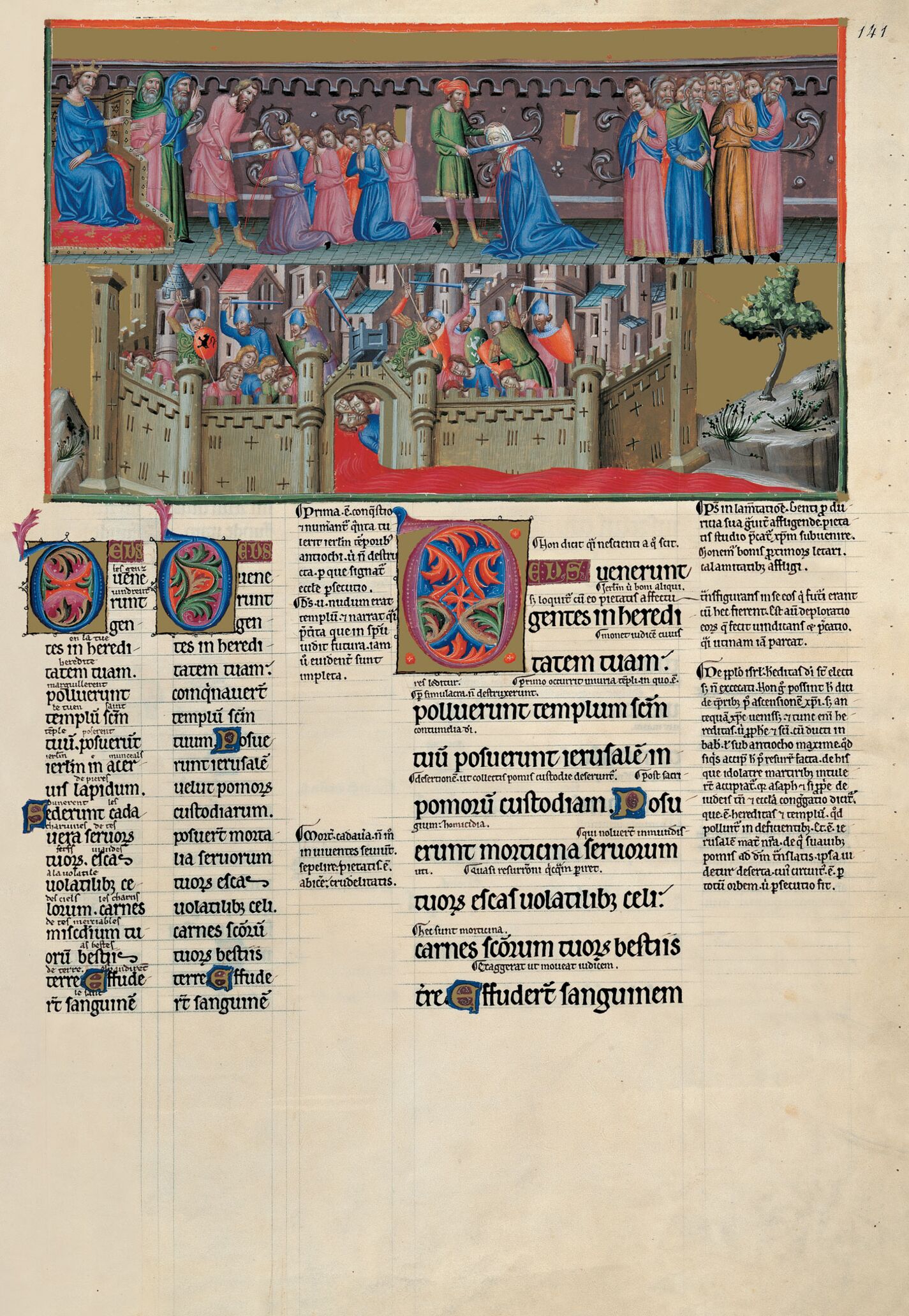In this instance, the interpretation of the psalm endorses the pictorial content of f. 141 quite clearly and directly. The first register portrays, against a lilac wall in the background decorated with the typical foliate motifs and blind arcades, the outcome of the orders given by an enthroned king. He is accompanied by a pair of Hebrews with covered heads and long beards, and his seat is decorated with a very dark red cloth reminiscent of the colour of the blood that he himself will cause to be spilt. His outstretched arm links the power he wields to the death of seven persons kneeling in prayer, who represent the innocents or the faithful referred to in the psalm, for whom divine justice is beseeched (v. 11-12, ...posside filios mortificatorum. Et redde vicinis nostris septuplum in sinu eorum: improperium ipsorum, quod exprobraverunt tibi Domine... // take possession of the children of them that have been put to death. And render to our neighbours sevenfold in their bosom: the reproach wherewith they have reproached thee, O Lord). An executioner holds the first faithful by the hair and decapitates him with his sword in a gesture suggesting a right to left rather than a downwards movement. Blood gushes from the neck of the sacrificed man like the neck of the woman slightly further to the right suffering the same fate at the hands of another executioner wearing a red turban. The woman draws attention to the Daughter of Zion, i.e. the city of Jerusalem (v. 1), but could also evoke the woman committed to the City of God (the other Jerusalem) and who triumphs over sin. Even further to the right a group of at least eight figures can be seen lamenting or saddened by these unjust executions. These are the deaths and sacrifice which the Psalter refers to (v. 2, Posuerunt morticina servorum tuorum, escas volatilibus coeli: carnes sanctorum tuorum bestiis terrae // They have given the dead bodies of thy servants to be meat for the fowls of the air: the flesh of thy saints for the beasts of the earth). A superfluous reference that also leads us to Jerusalem. After witnessing the discriminate and detailed execution of the faithful in the spaces in the first register, the miniature’s second register reflects a slaughter that is multiplied at the hands of the army which strikes and murders the male and female inhabitants of the earthly Jerusalem. The deaths are so numerous that a veritable river of blood flows through the gates in the city walls. This is the notorious red stain mentioned in the psalm (v. 3, Effunderunt sanguinem eorum tanquam aquam in circuitu Jerusalén: et non erat qui sepeliret // They have poured out their blood as water, round about Jerusalem and there was none to bury them) of a liquid spilt like water around Jerusalem, a complex city with its Italian-style roofs and turrets, towers and watchtowers borrowed from this and other hemispheres. As in the slaughter of the innocents, the city’s inhabitants do not fight. It is the soldiers – with red and green shields bedecked with rampant lions, and wearing blue, round or pointed helmets, and the occasional breastplate taken directly from the Giottesque world – who ferociously wound everyone with their swords or spears, leaving no one to bury the dead (v. 3, ...et non erat qui sepeliret // and there was none to bury them). A single tree on an outcrop and a few shrubs on the rocks represent the outskirts of the city, assailed by a relentless army.
